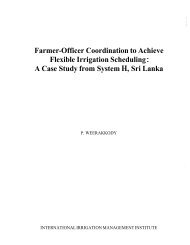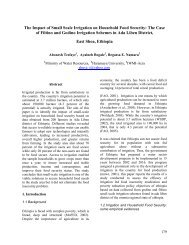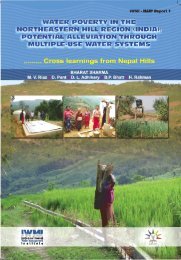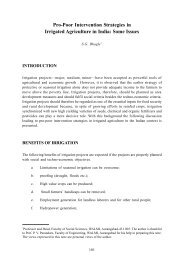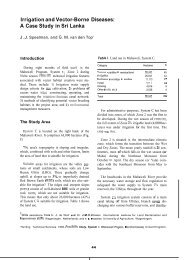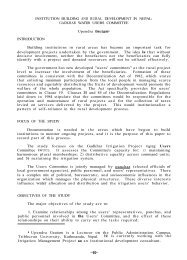David Molden, R Sakthivadivel and M Samad - International Water ...
David Molden, R Sakthivadivel and M Samad - International Water ...
David Molden, R Sakthivadivel and M Samad - International Water ...
You also want an ePaper? Increase the reach of your titles
YUMPU automatically turns print PDFs into web optimized ePapers that Google loves.
<strong>Molden</strong>, Sakthivadive/ <strong>and</strong> Saroad: Accounting for Changes in <strong>Water</strong> Use<br />
flows. Initially, some farmers benefited, while water scarcity remained a reality<br />
for other less fortunate people in spite of plentiful reservoir supplies. Significant<br />
water re-entered the river as drainage return flows, <strong>and</strong> navigation remained<br />
possible. Yet prosperous farmers needed more water to produce more food for<br />
the nation, so serious efforts were placed in improving management <strong>and</strong> serving<br />
all users. Return flows dwindled, <strong>and</strong> navigation was no longer possible.<br />
To further exp<strong>and</strong> irrigated agriculture <strong>and</strong> to meet urban dem<strong>and</strong>s, individuals<br />
installed pumps to extract water from aquifers <strong>and</strong> drains. Conflicts developed<br />
as upstream uSl;lrs infringed on the traditional rights of downstream users.<br />
Pollution became a concern as urban <strong>and</strong> industrial effluents increased, <strong>and</strong> little<br />
water remained to dilute flows. Wetl<strong>and</strong>s near the coast dried up. Poor people<br />
were left struggling to get sufficient drinking water. Alarmed, communities decided<br />
to take action ...<br />
2. Introduction<br />
Over the last 50 years, changes in the way humans use water have been<br />
enormous. Major driving factors have been a growing popUlation, economic<br />
development, improved living st<strong>and</strong>ards, <strong>and</strong> increasing dem<strong>and</strong>s. Irrigated<br />
agriculture has played a significant role in changing the face of water resource<br />
utilisation as dam, diversion, delivery <strong>and</strong> drainage structures have been<br />
developed to store <strong>and</strong> distribute water for irrigation <strong>and</strong> to drain out surplus<br />
supplies, With more development, we find ourselves in a situation where we have<br />
widely different <strong>and</strong> competing interests in our water resources.<br />
Our working hypothesis is that changing patterns of water use require adaptive<br />
institutions for sustainable, equitable, <strong>and</strong> productive management of basin wide<br />
resource. There is no one set of institutional arrangements that is capable to<br />
adequately manage the present situation, then meet future needs. An important<br />
feature of institutions is the mechanisms they employ to adapt to change.<br />
In order to underst<strong>and</strong> present uses of water, past trends, <strong>and</strong> future projections,<br />
it is essential to underst<strong>and</strong> the physical resource base. Here we present basic<br />
concepts of water accounting as a means of providing this underst<strong>and</strong>ing. We<br />
use water accounting to develop <strong>and</strong> present various phases of water resource<br />
development, <strong>and</strong> problems that are faced during the various phases. We illustrate<br />
these concepts by examples from Nepal <strong>and</strong> China.<br />
3. Accounting for <strong>Water</strong> Use<br />
How much water is available for use within basins or sub-basins? Who are the<br />
major users of the water resource? How much do they use? Is there scope for<br />
water savings, or scope for more development of water resources? These are<br />
the types of questions that can be addressed through the IWMI water accounting<br />
framework (<strong>Molden</strong> <strong>and</strong> <strong>Sakthivadivel</strong>, 1998).<br />
<strong>Water</strong> balance <strong>and</strong> water accounting. <strong>Water</strong> accounting relies on water balance<br />
studies. We define a domain bounded in space <strong>and</strong> by time. For example, we may<br />
74



